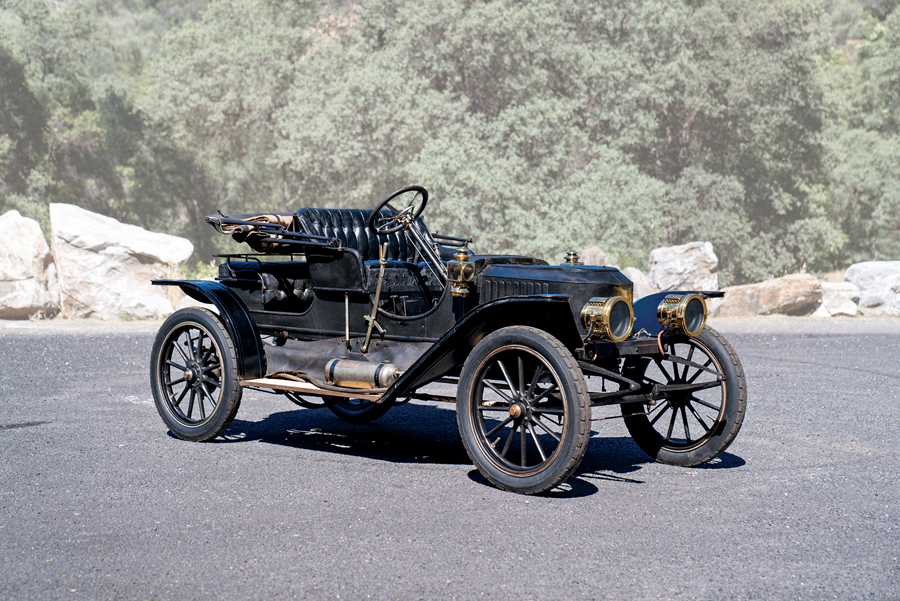- Held for over 70 years in the Buess Family Collection of Brass and Steam cars
- A particularly original example
- Optional 25-inch wheels
- Gas-fired headlights
- 2-seat runabout body
SCM Analysis
Detailing
| Vehicle: | 1910 Stanley Model 60 Runabout |
| Years Produced: | 1901–24 |
| Number Produced: | 10,830 (all models) |
| Original List Price: | $850 |
| SCM Valuation: | $55,000 |
| Tune Up Cost: | N/A |
| Chassis Number Location: | Brass plate, rear of body |
| Engine Number Location: | Stamped on valve linkage |
| Alternatives: | 1901–11 White, 1906–31 Doble, 1901–24 Stanley |
| Investment Grade: | C |
This car, Lot 130, sold for $95,200, including buyer’s premium, at the Gooding & Company auction on August 16–17, 2019, in Pebble Beach, CA.
It’s challenging to say anything definitive about the market for steam cars. There are few cars available, and the small group of people who buy them are a particular breed of collector.
The most important thing to remember is that when a Stanley (or a Doble or White) steam car comes to auction, it’s usually more of an individual than any other car.
The very youngest Stanley models are approaching 100 years old, and the last of the Dobles came off the line in 1931. These cars hail from the coachbuilt era, and even if they were standard models, owner modifications over the succeeding decades were close to inevitable.
Why choose steam?
Everything about a steam-powered car looks strange to modern eyes. All those valves and pressure gauges look more like an art display in a vintage plumbing-fixtures store than a set of controls for a car.
However, our great-grandfathers would have considered a steam car to be the most prudent and conservative choice on the road. To the car-buying public in 1910, a steam engine was proven and reliable technology that had been in widespread use pulling trains for almost a century.
Compared to a steam car, a gasoline-fueled internal-combustion engine might seem faddish, unproven and harder to support. Plus, you could break your arm trying to start one of Henry Ford’s Tin Lizzies.
Finally, steam cars represented the ultimate performance option in their day. Back in 1906, Fred Marriott became the fastest man in the world driving a Stanley up to 127.66 mph. That record stood until 1922.
As we know, the gas-powered internal-combustion engine eventually crowded out the steam engine, largely due to the invention of the electric starter motor by Cadillac in 1912. As gas-powered cars got easier and safer to use, the more-expensive steam engines fell out of favor and disappeared.
Boiling down the market
One thing becomes clear when you analyze steam-car sales: The market is unusually stable. Last year, I asked Jay Leno, one of the leading authorities on collecting steam cars, for a comment.
“A Stanley is different from other cars in that they reach a price plateau and then they stay there,” Leno said. “Then they go to the next plateau and they just stay there. I don’t think it’s a car you would ever buy for an investment. It’s one of the few cars where the joy is in the actual operating of the car.”
It’s only original once
Like all Stanleys, the Runabout that sold in Monterey is unique. Its history is known back to 1937, when it was acquired into the Fred Buess Collection. Because it sat undriven in the collection from 1946 to 2010, this Stanley missed out on at least one restoration cycle and probably more. As a result, it’s a time capsule. That has value in itself, but how much value is an open question. Recent market-leading sales have all been made by less-original but more-attractive Stanleys.
In the past year, a restored 1913 Model 64 sold for $115,500 (ACC# 6883969) and a rare and restored 1909 Stanley Mountain Wagon sold for $130,000 (ACC# 6883970). On the other side of the coin, a restored 1910 Stanley Model 60 Touring failed to sell on a high bid of $44,063 in the U.K. in June (ACC# 6907792). Earlier this spring, a project-grade 1923 Stanley sold for $8,064 (ACC# 6905838).
A tough room
Perhaps it was just misfortune that this car came up for sale during a summer of unpredictable auction results. It’s also possible that the seller or auctioneer had unrealistic expectations of the car’s value. For whatever reason, the pre-auction estimate for this car was $140,000 to $180,000. That’s still a long way from the highest price ever paid for a Stanley at $298,500 back in 2008 (ACC# 118125), but it would have been the highest price paid in the past few years. Yet like so many cars in Monterey, this Stanley drew only about half its high estimate, making it very well bought.
Another factor to keep in mind is that this same car sold to this year’s seller for $93,500 in 2010. (ACC# 162620). After putting some effort into getting the car running again, this year’s sale price had to have been deeply disappointing.
The newest owner now faces a dilemma: Do you make an investment in an award-winning restoration, or leave the car in its current drivable but somewhat rough original condition? A good case can be made for either option.
Either way, it looks like the current plateau of Stanley prices will be with us for a while longer.
(Introductory description courtesy of Gooding & Company.)
